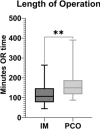Intramedullary nailing versus plate compound osteosynthesis in subtrochanteric and diaphyseal pathologic femoral fractures: a retrospective cohort study
- PMID: 37246990
- PMCID: PMC10651703
- DOI: 10.1007/s00590-023-03599-7
Intramedullary nailing versus plate compound osteosynthesis in subtrochanteric and diaphyseal pathologic femoral fractures: a retrospective cohort study
Abstract
Purpose: Pathologic fractures of the extremities due to carcinoma metastases require individual and patient prognosis-related stabilization procedures. Quick remobilization of the patient to restore the quality of life is of high importance, especially in the case of subtrochanteric and diaphyseal femoral fractures. In our retrospective cohort study, we evaluated intraoperative blood loss, length of operation, complication rate, and regain of lower extremity function in plate compound osteosynthesis (PCO) versus intramedullary nailing (IM) for subtrochanteric and diaphyseal pathologic fractures of the femur.
Methods: Between January 2010 and July 2021, we retrospectively reviewed 49 patients who were treated at our institution for pathologic fractures of the subtrochanteric and diaphyseal femurs for group differences in terms of blood loss, length of operation, implant survival, and Musculoskeletal Tumor Society (MSTS) score.
Results: We included 49 stabilization procedures of the lower extremity due to pathologic fractures of the proximal or diaphyseal femur, with a mean follow-up of 17.7 months. IM (n = 29) had a significantly shorter operation time than PCO (n = 20) (112.4 ± 9.4 and 163.3 ± 15.96 min, respectively). We did not detect any significant differences in terms of blood loss, complication rate, implant survival, or MSTS score.
Conclusion: Based on our data, pathologic subtrochanteric and diaphyseal fractures of the femur can be stabilized with IM, which has a shorter operation time than PCO, but the complication rate, implant survival, and blood loss remain unaffected.
Keywords: Compound osteosynthesis; Metastatic disease; Palliative surgery; Proximal femoral metastasis; Skeletal metastases; Skeletal-related events.
© 2023. The Author(s).
Conflict of interest statement
The authors declare that they have no conflicts of interest.
Figures
References
-
- Janssen SJ, Kortlever JT, Ready JE, Raskin KA, Ferrone ML, Hornicek FJ, Lozano-Calderon SA, Schwab JH. Complications after surgical management of proximal femoral metastasis: a retrospective study of 417 patients. J Am Acad Orthop Surg. 2016;24(7):483–494. doi: 10.5435/JAAOS-D-16-00043. - DOI - PubMed
-
- Willeumier JJ, Kaynak M, van der Zwaal P, Meylaerts SAG, Mathijssen NMC, Jutte PC, Tsagozis P, Wedin R, van de Sande MAJ, Fiocco M, Dijkstra PDS. What factors are associated with implant breakage and revision after intramedullary nailing for femoral metastases? Clin Orthop Relat Res. 2018;476(9):1823–1833. doi: 10.1007/s11999.0000000000000201. - DOI - PMC - PubMed
-
- Meynard P, Seguineau A, Laumonerie P, Fabre T, Foltran D, Niglis L, Descamps J, Bouthors C, Lebaron M, Szymanski C, Sailhan F, Bonnevialle P, MembersoftheSoF Surgical management of proximal femoral metastasis: fixation or hip replacement? A 309 case series. Orthop Traumatol Surg Res. 2020;106(6):1013–1023. doi: 10.1016/j.otsr.2020.05.007. - DOI - PubMed
MeSH terms
LinkOut - more resources
Full Text Sources
Medical




